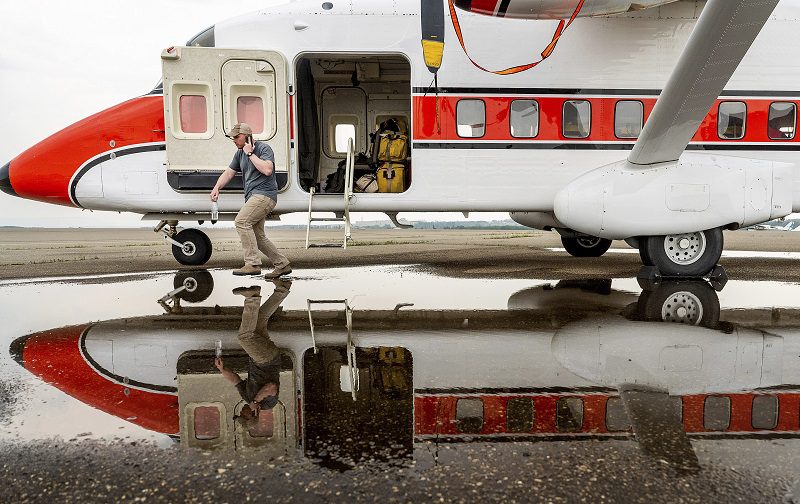Canada’s wildfires: Is industry concerned about lack of firefighters?

With Canada’s record-breaking fire season continuing to burn hot, firefighter availability and the country’s system of sharing resources is stretched thin.
For Canada’s P&C insurance industry, the overall lack of firefighters is a concern, given the sheer number of fires burning — 4,356 in total for the year as of Friday afternoon, according to the Canadian Interagency Forest Fire Centre (CIFFC). That’s nearly 1,000 more than the 10-year average of about 3,400.
It’s still too early to determine what insured damages will look like, other than for Nova Scotia’s Tantallon wildfire, which has already caused more than $165 million in losses.
“That number is likely going to be going up over time as we start to get better estimates and we know how long people are going to be out and how long it takes to rebuild,” Rob de Pruis, Insurance Bureau of Canada’s national director of consumer and industry relations, told Canadian Underwriter. “We have many other events [for which] we just haven’t even started that quantification.
“There’s many people in B.C., for example, that are currently under evacuation order. And there’s new fires popping up every day. We’re right in the middle of the peak of wildfire season and we still have several months to go before we’re essentially considering the season to come to an end.”
Canada generally has a good system of moving provincial resources around the country to where they’re needed, but this year that system is strained, added Glenn McGillivray, managing director of the Institute for Catastrophic Loss Reduction.
When asked if the lack of firefighters is a concern to the industry, de Pruis said, “the short answer is yes because the insurance industry is fundamentally concerned with risk and then with insured damages.”
FILE – Smoke billows from the Donnie Creek wildfire burning north of Fort St. John, British Columbia, Canada, Sunday, July 2, 2023. (AP Photo/Noah Berger, File)
He noted that while Canada’s firefighters do an excellent job of protecting lives and property, most community fire departments are staffed by volunteers who may not be properly equipped to deal with the overall volume of fires.
“We know in Alberta early in the season, there was a call out for anyone with wildfire-fighting experience and government would pay people, do some limited training and get them to assist,” de Pruis said. “I had a few friends that actually signed up and were on the frontlines fighting fires. It’s kind of remarkable when you have to do that call out.”
McGillivray said Canada’s system of moving resources around the country — run by CIFFC — allows for the movement of ‘boots on the ground’ and aviation resources. CIFFC also makes arrangements to use wildland firefighters from other countries (often from south of the equator, where the fire season runs contra to Canada’s).
“This year, CIFFC has brought in firefighters from a range of countries, not just the U.S.,” McGillivray noted. “We are fortunate that U.S. resources are available this season, but they may not be in the future if both countries have a busy fire season.”
Canada also leans on the military, but this isn’t sustainable, McGillivray said. “What happens if our troops are engaged somewhere sometime in the future during a bad wildfire season?” he asked. “We need more sustainable plans.”
Some have been pushing for the formation of a federal wildland firefighting force that could be moved around to assist the provinces and territories. But McGillivray said he is not sure if this approach is needed. “Others have pushed for a federal tanker fleet that could be lent to the provinces and territories during bad years. This is not an entirely bad idea.”
The Canadian Association of Fire Chiefs has called for more resources and training, something IBC supports. Yet it’s bigger than that — extreme weather events (including wildfires) are just the latest evidence action is needed now to build the country’s resilience and better protect communities, de Pruis said.
In particular, IBC would like to see “proper implementation and design, and specific targets” in Canada’s National Adaptation Strategy. “Because it’s only when we have those targets and we achieve those targets that we’ll be in a better position.”
He couldn’t say exactly what those targets would be, but noted there needs to be collaboration with industry, the federal government and stakeholders.
Feature image: U.S. Forest Service co-pilot Matt Berggren steps through a puddle while exiting a plane in Fort St. John, British Columbia, Wednesday, July 5, 2023. U.S. smokejumpers are assisting Canadian firefighters battling blazes throughout the region. (AP Photo/Noah Berger)



